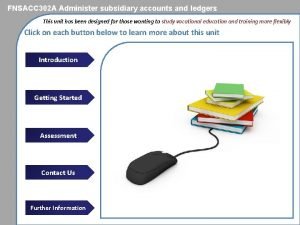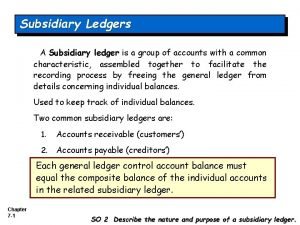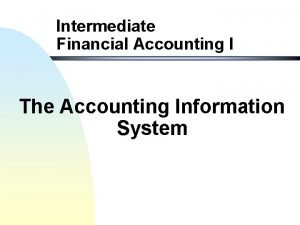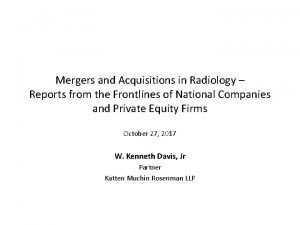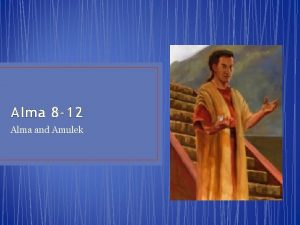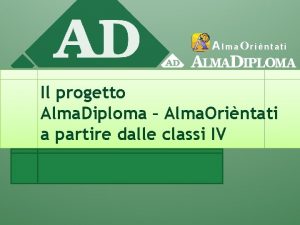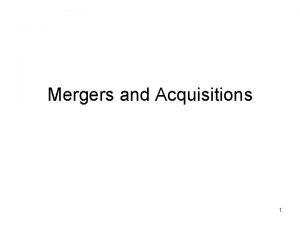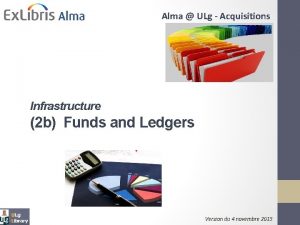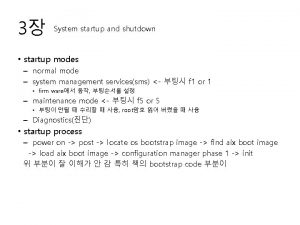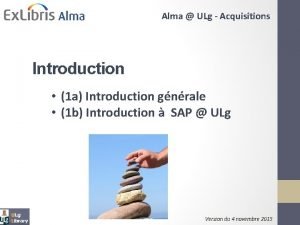ALMA ACQUISITIONS Startup training week 1 Ledgers and



















- Slides: 19

ALMA ACQUISITIONS Start-up training week 1: Ledgers and Funds

ACQUISITIONS WORKING GROUP POLICIES

AWG-1 POLICY: MINIMAL USE OF ALMA FOR ACQUISITIONS Recommend that all SUNY libraries adopting the Alma LSP use the Acquisitions functionality to manage their acquisitions activities. Activities may include, but are not limited to: ordering, receiving, invoicing, budget management and vendor administration for physical materials, electronic collections, and digital resources.

AWG-1 POLICY: MINIMAL USE OF ALMA FOR ACQUISITIONS -- JUSTIFICATION ■ Alma is a "Unified Resource Management" system. Other functional areas like E-Resource Management and Analytics require acquisitions data. ■ Both the individual institution and SUNY will benefit from the ability to share acquisitionsrelated data. ■ Alma's acquisitions functionality should make work more efficient. ■ Immediate access to financial details will provide each library with operational data and insight. ■ Presents opportunities for coordinated collection development. ■ When legally permitted, the increased collaboration and accountability offered by sharing acquisitions data meets a SUNY Strategic plan goal. ■ Shared information may result in a decrease in duplication of titles and an increase in the breadth the SUNY-wide collection.

AWG-1 POLICY: MINIMAL USE OF ALMA FOR ACQUISITIONS -- LINKS Link to AWG-1: https: //public. 3. basecamp. com/p/EYk. M 1 p. Vj. Vh. M 12 r. N 8 Ynm. Ne 9 Xy Policy: Minimum Acquisitions Data (Orbis Cascade Alliance). Accessed June 2018. https: //www. orbiscascade. org/minimum-acquisitions-data/ FAQ for the shared system: 37 to one (Orbis Cascade Alliance). Accessed June 2018. https: //www. orbiscascade. org/faq-for-shared-system-37 Ordering Using the Alma Network Zone (ULMS Technical Services) Accessed June 2018. https: //calstate. atlassian. net/wiki/spaces/ULMST/pages/61112697/Ordering+Using+ the+Alma+Network+Zone#Ordering. Usingthe. Alma. Network. Zone-Policy. Statement

AWG-2 POLICY: FUND STRUCTURE IN ALMA Recommend that SUNY libraries using Alma Acquisitions develop their fund structure within the guidelines detailed below. For information on Gifts, and related Funds, see AWG-5 Guidelines: Gifts and Gift Receiving. https: //public. 3. basecamp. com/p/mnv. Xukk 75 Fmr. Rg. K 8 BHCz 1 Dyo

AWG-2 POLICY: FUND STRUCTURE IN ALMA – BACKGROUND INFORMATION / CONCEPTS / ALMA STRUCTURE – Alma Acquisitions requires a minimum of one ledger and one allocated fund in LEDGERS AND FUNDS order to function. Ledgers generally reflect the source of the funds. You could set up separate ledgers for "regular" money, grant money, endowments, and the like. You may want or need more than one ledger: ■ in order to align ledgers with your payments office; ■ if you have a funding source that is intended for use by only one campus library or collection. You must create a separate ledger for a funding source if it has its own fiscal year start and end date.

AWG-2 POLICY: FUND STRUCTURE IN ALMA – BACKGROUND INFORMATION / CONCEPTS / ALMA STRUCTURE – Libraries may have as many allocated funds within each ledger as deemed ALLOCATED FUNDS necessary. These could be tied to (and named for) academic departments, for example, or certain locations or collections (e. g. , Reserves) as well as by format (e. g. , DVD) or purchase type (firm orders, subscriptions, etc. ) or according to categories used by the campus payments office. You may want to create a group of allocated funds for an academic program, separated by order or payment type. For example, an anthropology one-time purchase fund, an anthropology standing order fund, and an anthropology subscription fund. Individual orders are assigned to (and billed against) one (or more) allocated fund within the same ledger.

AWG-2 POLICY: FUND STRUCTURE IN ALMA – BACKGROUND INFORMATION / CONCEPTS / ALMA STRUCTURE – CODES AND NAMES When creating ledgers and allocated funds, you will assign each a code and a name. The code is fixed; the name is not. Do not include the year in the code. However, you may include the year in the name. So, a code might be Perkins Grant, while the name might be Perkins FY 18. In subsequent years, when the ledgers and allocated funds roll over, the code will remain Perkins Grant and you will have the option to change the name (e. g. to Perkins FY 19).

AWG-2 POLICY: FUND STRUCTURE IN ALMA – BACKGROUND INFORMATION / CONCEPTS / ALMA STRUCTURE – For ease of monitoring expenditures through a fiscal year, allocated funds can be SUMMARY FUNDS assigned to a summary fund. A summary fund could cluster funds by purchase type, for example, making it easy to see how much money is available, across all the allocated funds in that ledger, for one-time purchases. Summary funds might instead be used to mirror categories used by the campus business office or other reporting agencies. Notes: ■ No allocated fund can be assigned to more than one summary fund. ■ No summary fund can be assigned to more than one ledger. ■ Summary funds can be nested. ■ Alma Analytics offers several ways to monitor and group expenditures.

AWG-2 POLICY: FUND STRUCTURE IN ALMA – BACKGROUND INFORMATION / CONCEPTS / ALMA STRUCTURE – ■ Acquisitions Conceptual Background (Ex Libris) RESOURCES https: //knowledge. exlibrisgroup. com/Alma/Training/Alma_Essentials/Alma_Es sentials_-_English/D_Acquisitions/01_Acquisitions_Conceptual_Background ■ Funds and Ledgers in Alma (Cal. State, April 2017) https: //calstate. atlassian. net/wiki/spaces/ULMST/pages/77796538/Funds+Ledg ers+in+Alma ■ Managing Funds and Ledgers (Ex Libris) https: //knowledge. exlibrisgroup. com/Alma/Product_Documentation/010 Alma_ Online_Help_(English)/020 Acquisitions/090 Acquisitions_Infrastructure/020 Ma naging_Funds_and_Ledgers ■ Vanguard Workshop: Technical Services Overview (includes fund structure) (Brockport, June 2018) http: //www. kaltura. com/tiny/zmli 8

FUNDS AND LEDGERS How-to and structure

First things first: roles To manage funds, you must have the following role: ■ Fund Manager ■ Fund-Ledger Viewer (view only) To manage ledgers, you must have the following role: ■ Ledger Manager ■ Fund-Ledger Viewer (view only) Your role's scope may limit you to funds or ledgers available only to particular libraries.

Funds and Ledgers ■ An allocated fund represents money in an account. Orders will be charged against allocated funds. ■ A summary fund groups allocated funds for reporting purposes ■ A ledger is essentially a collection of funds. Ledgers are defined for a specific date range, such as September 1 of this year to August 31 of next year. You manage funds and ledgers from the Funds and Ledgers page (Acquisitions > Acquisitions Infrastructure > Funds and Ledgers).

Creating your fund structure: from the top ■ First, create your ledger(s) ■ Next, create any summary funds desired (these are optional but can be useful for reporting) ■ Finally, create your allocated funds (this is where the money goes) Example: I have my main ledger, state funds. I create a summary fund for Sociolology materials so I can easily see a roll-up of all the funds I have for this subject area, and under that summary fund I create three allocated funds: Sociology books, sociology journals, and sociology media. I can then allocate money to those specific allocated funds, and spend that money when I purchase materials.




 Alma alma piros alma beteszlek a kosaramba
Alma alma piros alma beteszlek a kosaramba Administer subsidiary accounts and ledgers
Administer subsidiary accounts and ledgers A subsidiary ledger is a group of:
A subsidiary ledger is a group of: Accounts payable subsidiary ledger
Accounts payable subsidiary ledger örtük model alma nedir
örtük model alma nedir Week by week plans for documenting children's development
Week by week plans for documenting children's development Radiology mergers and acquisitions
Radiology mergers and acquisitions Hr issues in mergers and acquisitions
Hr issues in mergers and acquisitions Franchise mergers & acquisitions advisors
Franchise mergers & acquisitions advisors Cycle based testing audit
Cycle based testing audit Corporate restructuring
Corporate restructuring Mergers and acquisitions in strategic management
Mergers and acquisitions in strategic management Mergers and acquisitions rumors
Mergers and acquisitions rumors Vertical complementary strategic alliance
Vertical complementary strategic alliance Acquisitions and payments cycle
Acquisitions and payments cycle United states acquisitions and annexations 1857-1904
United states acquisitions and annexations 1857-1904 What is merger and consolidation
What is merger and consolidation Alliances and acquisitions
Alliances and acquisitions When are capabilities-motivated acquisitions essential?
When are capabilities-motivated acquisitions essential? Slave state
Slave state

